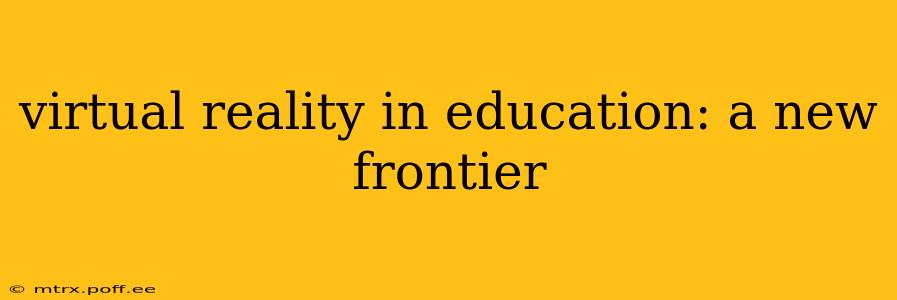Virtual Reality (VR) is rapidly transforming numerous sectors, and education is no exception. This immersive technology offers unparalleled opportunities to enhance learning experiences, making education more engaging, effective, and accessible for students of all ages and learning styles. This article explores the exciting potential of VR in education, addressing common questions and showcasing its transformative power.
What are the benefits of using VR in education?
VR offers a multitude of benefits in the educational landscape. It transcends the limitations of traditional classroom learning by creating highly interactive and engaging environments. Students can participate in virtual field trips to historical sites, explore the human body in unprecedented detail, or even travel to outer space – all without leaving the classroom. The immersive nature of VR fosters deeper understanding and knowledge retention, making learning a more memorable and enjoyable experience. Furthermore, VR can cater to diverse learning styles, providing personalized learning experiences tailored to individual needs. This is particularly beneficial for students who may struggle with traditional teaching methods.
How can VR improve student engagement and motivation?
One of the most significant advantages of VR in education is its ability to drastically improve student engagement and motivation. The interactive and immersive nature of VR captivates students' attention, fostering a sense of excitement and curiosity. Instead of passively absorbing information, students actively participate in the learning process, leading to increased motivation and a deeper desire to learn. This increased engagement translates into improved academic performance and a more positive attitude towards education. The gamification aspects of many VR educational tools further enhance motivation by incorporating elements of competition, reward, and achievement.
What are some examples of VR applications in education?
The applications of VR in education are vast and constantly evolving. Here are a few examples:
-
Virtual Field Trips: Students can visit historical sites, explore natural wonders, or even travel to other planets without leaving the classroom. This provides a cost-effective and safe way to experience places and environments that would otherwise be inaccessible.
-
Interactive Simulations: VR can simulate real-world scenarios, such as medical procedures, engineering challenges, or historical events. This hands-on experience allows students to learn by doing, strengthening their understanding and problem-solving skills.
-
Immersive Storytelling: VR can create engaging narratives that transport students to different times and places, enriching their understanding of history, literature, and other subjects.
-
Personalized Learning: VR can adapt to individual student needs, providing customized learning experiences that cater to different learning styles and paces.
-
Accessibility: VR can make education more accessible to students with disabilities, offering tailored learning experiences that cater to their specific needs.
What are the challenges of using VR in education?
Despite its significant potential, the widespread adoption of VR in education faces several challenges. The high cost of VR equipment can be a barrier for many schools and institutions. The need for specialized training for teachers and staff is also a significant factor. Furthermore, the development of high-quality educational VR content requires significant time and resources. Addressing these challenges requires collaborative efforts from educators, technology developers, and policymakers.
Is VR in education expensive?
Yes, the initial investment in VR technology can be substantial. This includes the cost of headsets, computers, and software. However, the long-term benefits of increased engagement, improved learning outcomes, and enhanced accessibility may outweigh the initial investment. Furthermore, as technology advances, the cost of VR equipment is likely to decrease, making it more accessible to schools and institutions.
What are the future trends in VR education?
The future of VR in education is bright, with ongoing advancements promising even greater potential. We can expect to see more sophisticated and immersive VR experiences, more affordable hardware, and a wider range of educational applications. The development of more accessible and user-friendly software will also play a crucial role in the wider adoption of VR in education. Furthermore, the integration of VR with other emerging technologies, such as artificial intelligence (AI) and augmented reality (AR), will further enhance the learning experience.
Conclusion
Virtual Reality is poised to revolutionize education, offering a powerful tool to enhance learning, engagement, and accessibility. While challenges remain, the potential benefits are undeniable. As the technology continues to advance and become more affordable, VR will play an increasingly important role in shaping the future of education. The immersive, interactive, and personalized nature of VR promises to create a more engaging and effective learning environment for students worldwide.
